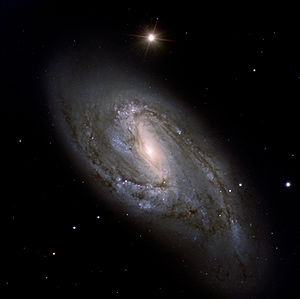Messier 66
| Galaxie Messier 66 | |
|---|---|
 | |
| ESO: Aufnahme des Very Large Telescopes von Messier 66. Der helle Stern unmittelbar oberhalb trägt die Bezeichnung BD +13° 2389 / SAO 99560. | |
| AladinLite | |
| Sternbild | Löwe |
| Position Äquinoktium: J2000.0, Epoche: J2000.0 | |
| Rektaszension | 11h 20m 14,9s [1] |
| Deklination | +12° 59′ 30″ [1] |
| Erscheinungsbild | |
| Morphologischer Typ | SAB(s)b;LINER Sy2[1] |
| Helligkeit (visuell) | 8,9 mag[2] |
| Helligkeit (B-Band) | 9,7 mag[2] |
| Winkelausdehnung | 9,1′ × 4,1′[2] |
| Positionswinkel | 173°[2] |
| Flächenhelligkeit | 12,7 mag/arcmin²[2] |
| Physikalische Daten | |
| Zugehörigkeit | M66-Gruppe LGG 231[1][3] |
| Rotverschiebung | 0,002425 ± 0,000010[1] |
| Radialgeschwindigkeit | (727 ± 3) km/s[1] |
| Hubbledistanz H0 = 73 km/(s • Mpc) | (29 ± 2) · 106 Lj (8,81 ± 0,62) Mpc [1] |
| Durchmesser | 95.000 Lj |
| Geschichte | |
| Entdeckung | Charles Messier |
| Entdeckungsdatum | 1. März 1780 |
| Katalogbezeichnungen | |
| M 66 • NGC 3627 • UGC 6346 • PGC 34695 • CGCG 067-057 • MCG +02-29-19 • IRAS 11176+1315 • Arp 16, Teil von 317 • VV 308a • GC 2377 • h 875? • Arak 288 • Holm 246A | |
Messier 66 (auch als NGC 3627 bezeichnet) ist eine 8,9 mag helle Spiralgalaxie vom Hubble-Typ Sb im Sternbild Löwe. Sie ist schon im Feldstecher sichtbar, ihr Durchmesser beträgt etwa 100 000 Lichtjahre.
Beschreibung
Zusammen mit Messier 65 und NGC 3628 bildet diese Galaxie das Leo-Triplett, den Kern der M66-Galaxiengruppe, welche sich in etwa 30 Millionen Lichtjahren (10 Mpc) Entfernung befindet. Halton Arp gliederte seinen Katalog ungewöhnlicher Galaxien nach rein morphologischen Kriterien in Gruppen. Dieses Galaxientriplett gehört zu der Klasse Gruppen von Galaxien. Außerdem gehört die Galaxie im Arp-Katalog zu der Klasse Spiralgalaxien mit abgetrennten Abschnitten.
In M66 wurden die Supernova SN 1989B (Typ Ia) und die mögliche Supernova SN 1997bs beobachtet, wobei es sich dabei auch um einen LBV-Ausbruch gehandelt haben könnte.
Die Galaxie ist bereits in einem lichtstarken Feldstecher zu erkennen. Sie wurde am 1. März 1780 von dem französischen Astronomen Charles Messier entdeckt.[4] Wissenschaftlich ist sie auch mit Weltraumteleskopen untersucht worden. Eine Studie mit dem Hubble-Weltraumteleskop zeigt aktive Bereiche in der H-alpha-Spektrallinie. Eine Überlagerung des visuellen Spektrums mit einer Infrarotaufnahme des Spitzer-Weltraumteleskops und einer Aufnahme der Gammastrahlung durch das Chandra-Weltraumteleskop lässt die Verteilung schwarzer Löcher hervortreten,[5] während Aufnahmen der Millimeterwellenstrahlung mithilfe des Atacama Large Millimeter/submillimeter Array Wolken aus kaltem, molekularen Gas zeigen.
- Multispektrale Aufnahme. Blau: Gammastrahlung; gelb: Sichtbares Licht; rot: Infrarot
- Aufnahme der Ultraviolettstrahlung mittels GALEX
- Infrarotaufnahme des Spitzer-Weltraumteleskops
- (c) ESA/Hubble, CC BY 4.0Eine Detailaufnahme des Hubble-Weltraumteleskops
- (c) NASA, ESA, CSA, STScI, J. Lee (STScI), T. Williams (Oxford), PHANGS Team, CC BY 4.0Detaillierte Infrarotaufnahmen mithilfe des James-Webb-Weltraumteleskops
- Aufnahme der Millimeterwellenstrahlung (orange) mithilfe des Atacama Large Millimeter/submillimeter Array
M66-Gruppe (LGG 231)
| Galaxie | Alternativname | Entfernung / Mio. Lj |
|---|---|---|
| NGC 3593 | PGC 34257 | 24 |
| NGC 3627 (M66) | PGC 34695 | 29 |
| NGC 3623 (M65) | PGC 34612 | 32 |
| NGC 3628 | PGC 34697 | 34 |
Weblinks
- M66 im Two Micron All Sky Survey
- ESO: Das VST wirft einen Blick auf das Leo-Triplett – und darüber hinaus (+Fotos, Karte & Animation) 27. Juli 2011
- astronews.com: Das Schwergewicht im Leo-Triplett 9. April 2010
- astronews.com: Bild des Tages 30. November 2012
- astronews.com: Bild des Tages 13. Februar 2013
- Spektrum.de: Amateuraufnahmen [1]
- Arp Atlas of Peculiar Galaxies
- Seligman Arp
Literatur
- Jeff Kanipe und Dennis Webb: The Arp Atlas of Peculiar Galaxies – A Chronicle and Observer´s Guide, Richmond 2006, ISBN 978-0-943396-76-7
- König, Michael & Binnewies, Stefan (2019): Bildatlas der Galaxien: Die Astrophysik hinter den Astrofotografien, Stuttgart: Kosmos, S. 141/367
Einzelnachweise
- ↑ a b c d e NASA/IPAC EXTRAGALACTIC DATABASE
- ↑ a b c d e SEDS: NGC 3627
- ↑ VizieR
- ↑ Seligman
- ↑ http://www.spitzer.caltech.edu/images/5512-sig12-013-Revealing-Hidden-Black-Holes
Auf dieser Seite verwendete Medien
Bildtafel der 110 Messier-Objekte. Diese Datei wird in der w:de:Template:Navigationsleiste Messierobjekte als Imagemap genutzt. Sie darf daher nicht durch eine andere Version überschrieben werden!
UV-Image of Messier 66made by GALEX
(c) NASA, ESA, CSA, STScI, J. Lee (STScI), T. Williams (Oxford), PHANGS Team, CC BY 4.0
This spiral galaxy was observed as part of the Physics at High Angular resolution in Nearby GalaxieS (PHANGS) program, a large project that includes observations from several space- and ground-based telescopes of many galaxies to help researchers study all phases of the star formation cycle, from the formation of stars within dusty gas clouds to the energy released in the process that creates the intricate structures revealed by Webb’s new images.NGC 3627 is 36 million light-years away in the constellation Leo.Learn more about what can be seen in this vast collection of Webb images here.[Image description: Webb’s image of NGC 3627 shows a face-on barred spiral galaxy anchored by its central region, which has a bright blue central dot. It is surrounded by a bar structure filled with a lighter blue haze of stars, which forms a large, angled oval toward the top. Two large distinct spiral arms appear as arcs that start at the central bar. One starts at left and stretches to the top and another starts at right and extends to the bottom.]
Autor/Urheber: ESO, Lizenz: CC BY 4.0
Colour composite image of the spiral galaxy M 66 (or NGC 3627) obtained with the FORS1 and FORS2 multi-mode instruments (at VLT MELIPAL and YEPUN, respectively). NGC 3627 is located in the constellation Leo (The Lion). It is a beautiful spiral with a well-developed central bulge. It also displays large-scale dust lanes. Many regions of warm hydrogen gas are seen throughout the disc of this galaxy. The latter regions are being ionised by radiation from clusters of newborn stars. North towards upper left, West towards upper right.
ID: phot-33c-03-fullres
Size: 2300x2294
Credit: ESONGC 3627 (M66)
(c) ESA/Hubble, CC BY 4.0
Hubble has snapped this view of Messier 66, the largest "player" of the Leo Triplet, and a galaxy with an unusual anatomy: it displays asymmetric spiral arms and an apparently displaced core. The peculiar anatomy is most likely caused by the gravitational pull of the other two members of the trio.
The unusual spiral galaxy, Messier 66, is located at a distance of about 35 million light-years in the constellation of Leo. Together with Messier 65 and NGC 3628, Messier 66 is the member of the Leo Triplet, a trio of interacting spiral galaxies, part of the larger Messier 66 group. Messier 66 wins in size over its fellow triplets — it is about 100 000 light-years across.
This is a composite of images obtained through the following filters: 814W (near infrared), 555W (green) and H-alpha (showing the glowing of the hydrogen gas). They have been combined so to represent the real colors of the galaxy.Revealing Hidden Black Holes
The spiral galaxy NGC 3627 is located about 30 million light years from Earth. This composite image includes X-ray data from NASA's Chandra X-ray Observatory (blue), infrared data from the Spitzer Space Telescope (red), and optical data from the Hubble Space Telescope and the Very Large Telescope (yellow). The inset shows the central region, which contains a bright X-ray source that is likely powered by material falling onto a supermassive black hole.
A search using archival data from previous Chandra observations of a sample of 62 nearby galaxies has shown that 37 of the galaxies, including NGC 3627, contain X-ray sources in their centers. Most of these sources are likely powered by central supermassive black holes. The survey, which also used data from the Spitzer Infrared Nearby Galaxy Survey, found that seven of the 37 sources are new supermassive black hole candidates.
Confirming previous Chandra results, this study finds the fraction of galaxies found to be hosting supermassive black holes is much higher than found with optical searches. This shows the ability of X-ray observations to find black holes in galaxies where relatively low-level black hole activity has either been hidden by obscuring material or washed out by the bright optical light of the galaxy.
The combined X-ray and infrared data suggest that the nuclear activity in a galaxy is not necessarily related to the amount of star-formation in the galaxy, contrary to some early claims. In contrast, these new results suggest that the mass of the supermassive black hole and the rate at which the black hole accretes matter are both greater for galaxies with greater total masses.
A paper describing these results was published in the April 10, 2011 issue of The Astrophysical Journal. The authors are Catherine Grier and Smita Mathur of The Ohio State University in Columbus, OH; Himel GHosh of CNRS/CEA-Saclay in Guf-sur-Yvette, France and Laura Ferrarese from Herzberg Institute of Astrophysics in Victoria, Canada.
NASA's Marshall Space Flight Center in Huntsville, Ala., manages the Chandra program for NASA's Science Mission Directorate in Washington. The Smithsonian Astrophysical Observatory controls Chandra's science and flight operations from Cambridge, Mass. About the Object
Credit
NASA/CXC/Ohio State Univ./C.Grier et al.; Optical: NASA/STScI, ESO/WFI; Infrared: NASA/JPL-Caltech
Name
NGC 3627
Type
Galaxy > Type > Spiral Galaxy > Component > Central Black Hole
Distance
29,000,000 Light Years
Color Mapping Band Wavelength Telescope X-ray 1.5 keV Chandra ACIS Optical 429 nm VLT WFI Optical 554 nm VLT WFI Optical 657 nm VLT WFI Optical 814 nm Hubble WFPC2 Optical 658 nm Hubble WFPC2 Optical 555 nm Hubble WFPC2 Optical 814 nm Hubble ACS/WFC Optical 555 nm Hubble ACS/WFC
Infrared 4.5 µm Spitzer IRACAutor/Urheber: ESO/PHANGS, Lizenz: CC BY 4.0
The NGC 3627 galaxy, also known as Messier 66, appears to be expelling flames out of its majestic spiral arms in this Picture of the Week. The “fire” actually marks clouds of cold molecular gas, which is the material out of which stars form, and has been captured using the Atacama Large Millimeter/submillimeter Array (ALMA) in Chile, of which ESO is a partner. The bluish regions in the background reveal the pattern of older, already formed stars, imaged by the Multi-Unit Spectroscopic Explorer (MUSE) on ESO’s Very Large Telescope (VLT) also in Chile.Located approximately 31 million light-years from Earth in the constellation Leo, NGC 3627 is one of the many galaxies observed as part of the Physics at High Angular resolution in Nearby GalaxieS (PHANGS) project. PHANGS is making high-resolution observations of nearby galaxies with telescopes operating across all colours or wavelengths of the electromagnetic spectrum. Different wavelengths can reveal a multitude of secrets about a galaxy, and by comparing them astronomers are able to study what triggers, boosts or hinders the birth of new stars.
















